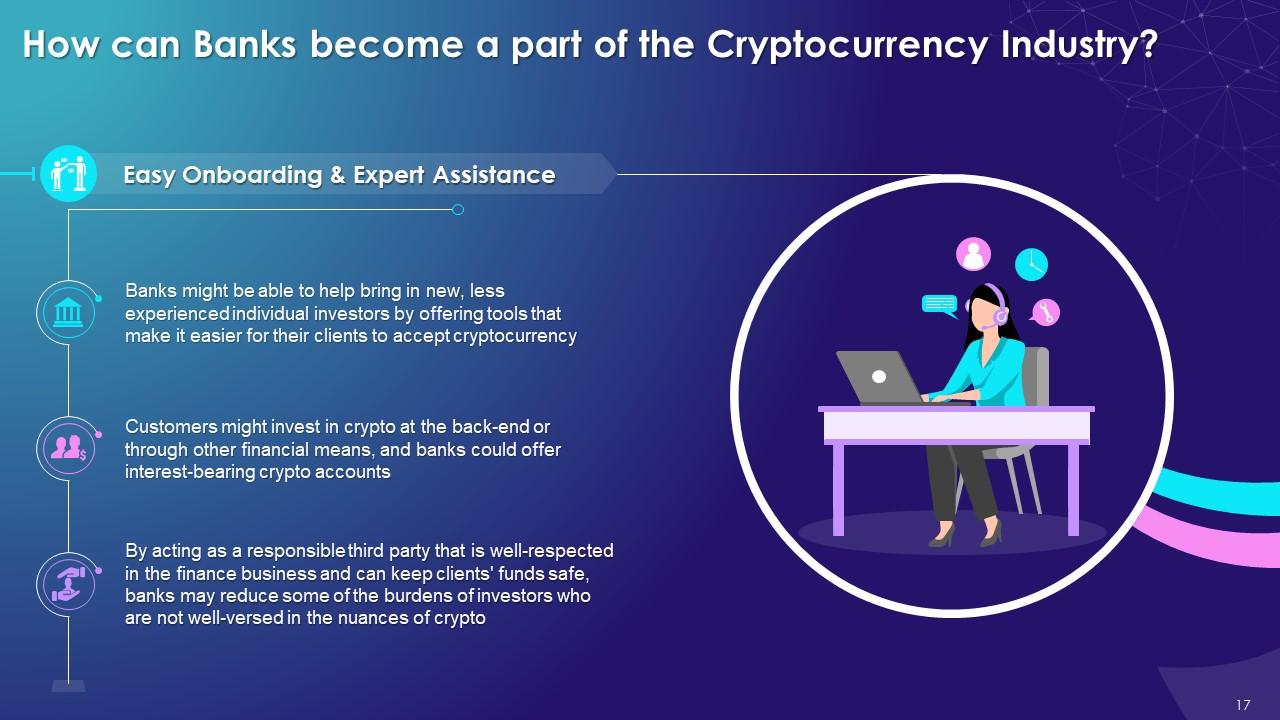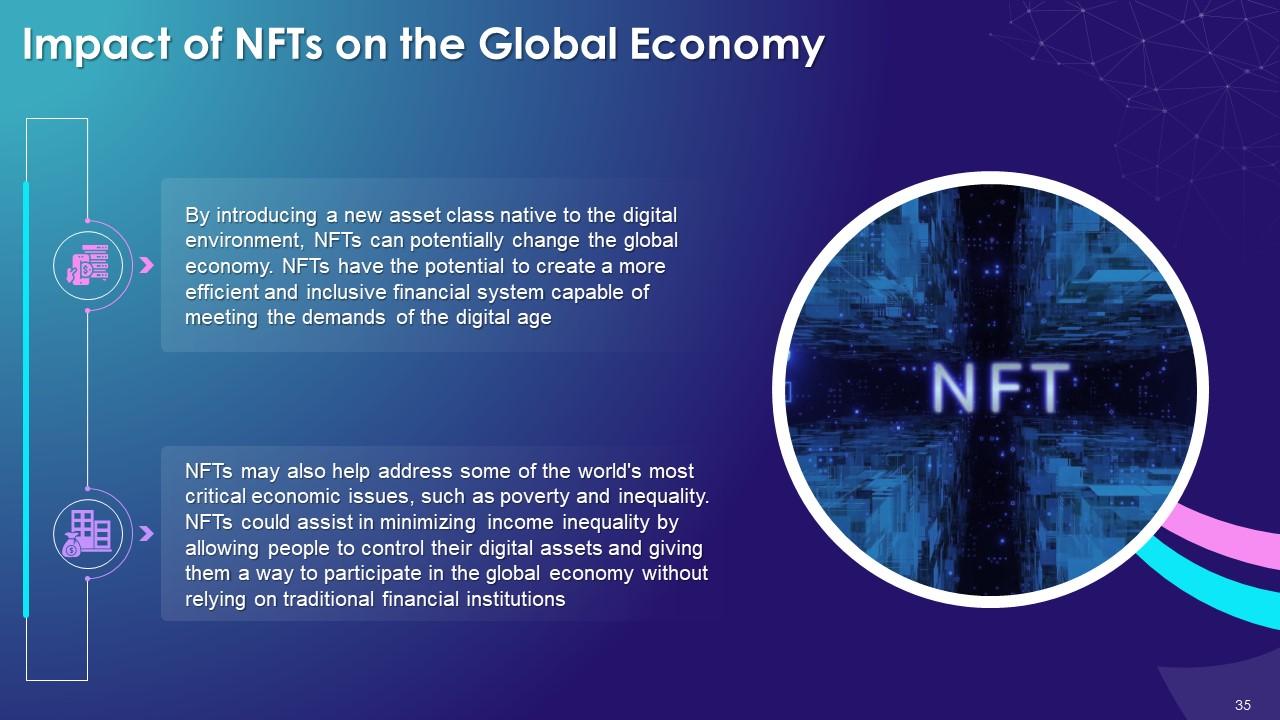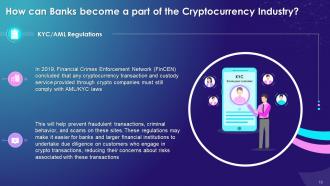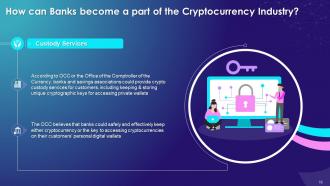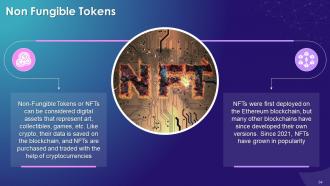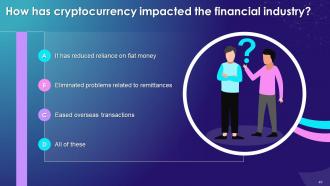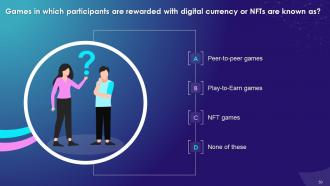Impact And Analysis Of Cryptocurrency Training Module On Blockchain Technology Application Training Ppt
This PPT training deck in-depth covers the impact of cryptocurrency on the financial industry, banking industry, entrepreneurship, job markets, and gaming industry. It also includes PowerPoint slides on the acceptance of cryptocurrencies by aid agencies, the impact of NFTs on the global economy, the environmental impact of cryptocurrencies, and cryptocurrency and crime. The PowerPoint module contains discussion questions and MCQs related to the topic to make the training session interactive. It also includes additional slides on about us, vision, mission, goal, 30-60-90 days plan, timeline, roadmap, training completion certificate, energizer activities, detailed client proposal, and training assessment form.
- Google Slides is a new FREE Presentation software from Google.
- All our content is 100% compatible with Google Slides.
- Just download our designs, and upload them to Google Slides and they will work automatically.
- Amaze your audience with SlideTeam and Google Slides.
-
Want Changes to This PPT Slide? Check out our Presentation Design Services
- WideScreen Aspect ratio is becoming a very popular format. When you download this product, the downloaded ZIP will contain this product in both standard and widescreen format.
-

- Some older products that we have may only be in standard format, but they can easily be converted to widescreen.
- To do this, please open the SlideTeam product in Powerpoint, and go to
- Design ( On the top bar) -> Page Setup -> and select "On-screen Show (16:9)” in the drop down for "Slides Sized for".
- The slide or theme will change to widescreen, and all graphics will adjust automatically. You can similarly convert our content to any other desired screen aspect ratio.
Compatible With Google Slides

Get This In WideScreen
You must be logged in to download this presentation.
PowerPoint presentation slides
Presenting Training Session on Impact and Analysis of Cryptocurrency. This deck comprises of 108 slides. Each slide is well crafted and designed by our PowerPoint experts. This PPT presentation is thoroughly researched by the experts and every slide consists of an appropriate content. All slides are customizable. You can add or delete the content as per your need. Not just this, you can also make the required changes in the charts and graphs. Download this professionally designed business presentation, add your content and present it with confidence.
People who downloaded this PowerPoint presentation also viewed the following :
Content of this Powerpoint Presentation
Slide 4
This slide delineates the five ways in which cryptocurrency has impacted the financial industry. Some of these include reduced reliance on fiat money, ease in overseas transactions, elimination of the need for a central regulatory agency, elimination of problems concerning remittances, and providing a new form of crowdfunding.
Slide 5
This slide discusses how the increased adoption of cryptocurrency has led to reduced reliance on fiat money. Cryptocurrencies are substituting fiat money at a rapid and increasing pace. Cryptocurrencies are immune to the political and financial problems that plague fiat money.
Slide 6
This slide talks about the increased overseas transactions as an impact of cryptocurrency on the financial industry. People may use cryptocurrencies without bank accounts; many of them are from developing nations with weak economies. They can now conduct financial transactions using cryptocurrencies like Bitcoin. Another appealing feature is how transaction fees. Cryptocurrencies are breaking down the barriers international banking institutions had erected.
Slide 7
This slide talks about how the introduction of cryptocurrencies has eliminated problems related to remittances. Cryptocurrencies get around the isolationist policies of some governments, which make it impossible for citizens to transfer money internationally. These have made it easier to send and receive money across the globe.
Slide 8
This slide talks about how the introduction of cryptocurrencies has eliminated the need for a central regulatory agency. The elimination of such central agencies results in a new market structure where a central authority does not influence the money market, money supply, and inflation
Slide 9
This slide highlights how cryptocurrencies have provided a new form of crowdfunding. This novel method is referred to as crypto equity financing. Investors acquire coins that are treated as stock in a firm. As a result, the investor owns a portion of the company. The coin's worth rises in tandem with the company's value and vice-versa.
Slide 11
This slide talks about the impact of cryptocurrency on the banking industry. Traditional banks are hesitant to embrace cryptocurrencies, even though the world of cryptocurrency is gradually developing and gaining popularity. Banks fear that the inherent risks outweigh the possible benefits.
Slide 12
This slide highlights the ways in which banks can be involved in the cryptocurrency industry. Cryptocurrency adoption can streamline, enhance, and modernize financial services. Some recent industry breakthroughs have alleviated banks' fears about the risks and allowed them to explore the potential benefits of cryptocurrency.
Slide 13
This slide discusses how banks can help in implementing KYC/AML regulations as a way to be part of the cryptocurrency industry. In 2019, Financial Crimes Enforcement Network (FinCEN) concluded that any cryptocurrency transactions and custody services provided through crypto companies must still comply with AML/KYC laws.
Instructor’s Notes:
Banks, loan officers, and other institutions could benefit from a streamlined view of shared data on individuals due to blockchain. This means that all client data may someday be stored on a single blockchain. All financial institutions might use this blockchain data, allowing for quick customer reviews and identifying any red flags that signal illicit or criminal behavior.
Slide 14
This slide discusses how banks can help in mitigating security concerns around cryptocurrency. Banks can assist cryptocurrency users be at ease with any security concerns. Many customers are worried about personal wallets and exchanges being hacked. Well-known banks may be able to assist in the protection of digital currencies from theft or hacking, putting clients' minds at ease.
Slide 15
This slide discusses how cryptocurrency can help banks in payment systems. As per the Office of the Comptroller of the Currency (OCC), banks can use public blockchains, including stablecoins, to speed up their payment operations.
Slide 16
This slide discusses how banks can help in setting up smart contracts and be part of the cryptocurrency industry. As the completion of the transactions is dependent on a computer code rather than an individual's behaviour, there is a reduced level of trust between the parties while entering into a smart contract arrangement. Banks could bridge this gap in trust by acting as a dependable third party for smart contracts used in commercial loans, mortgages, letters of credit, and other transactions.
Slide 17
This slide discusses how banks can help in providing easy onboarding services and expert assistance for the cryptocurrency industry. Banks might be able to help bring in new, less experienced individual investors by offering tools that make it easier for their clients to accept cryptocurrency. By acting as a responsible third party that is well-respected in the finance business and can keep clients' funds safe, banks may reduce some of the burdens of investors who aren't specialists in the nuances of crypto.
Slide 18
This slide discusses how banks can help in providing custody services for the cryptocurrency industry. According to OCC or the Office of the Comptroller of the Currency, banks and savings associations could provide crypto custody services for customers, including keeping unique cryptographic keys for accessing private wallets.
Slide 20
This slide discusses the economic impact of cryptocurrencies due to its low transaction costs. Transaction costs for most cryptocurrencies are low to almost nil. Users are not expected to account for any additional expenditures because decentralised cryptocurrencies and blockchain do not require investment in physical property. This implies that there is no requirement of rental property, or employee salaries to pay, unlike a bank office.
Slide 21
This slide talks about the impact of cryptocurrencies on entrepreneurship. Due to its decentralized nature, cryptocurrency is a global market in which any user, regardless of citizenship, can exchange currency. This is especially important for entrepreneurs who no longer deal with a domestic audience but with a worldwide audience with whom funds can be exchanged without the hassle of conversion rates or international law.
Slide 22
This slide discusses the economic impact of cryptocurrencies on job markets. The rising popularity of cryptocurrencies has increased the demand for crypto experts and professionals. The worldwide crypto sector is a large ecosystem with exchanges, and participants that require professionals to manage.
Instructor’s Notes:
According to a recent analysis by Indian industry group Nasscom and cryptocurrency exchange WazirX, the crypto business presently employs roughly 50,000 people. Th report adds that the sector has the potential to create 800,000 jobs by 2030 as more young people invest in cryptocurrencies.
Slide 24
This slide talks about the impact of cryptocurrency on the gaming industry. As new technologies emerge, the gaming industry is growing fast and expanding over time. Cryptocurrency fits very well with the gaming world since it is a universe that a large proportion of the public understand
Slide 25
This slide lists ways in which cryptocurrency has impacted the gaming industry. Some of these areas include crypto games, co-creator rewards, better work culture, international talent & usage, and casino industry
Slide 26
This slide talks about how cryptocurrency has entered the gaming world through crypto games. Participants in play-to-earn games are rewarded with digital cash or non-fungible tokens. These blockchain-based games, also known as P2E, have risen in popularity in recent years, with each platform having its own coin to compensate online gamers for their time.
Slide 27
This slide discusses the emergence of co-creator rewards in the gaming industry. There was no method to reward gamers who assisted in co-creating games in the early days of blockchain and cryptocurrencies. However, a suitable system can now be designed for rewarding gamers through cryptocurrency for their efforts.
Slide 28
This slide highlights the emergence of better work culture in the gaming industry due to the introduction of cryptocurrencies. The adoption of cryptocurrency will impact workers in the gaming sector, as well as other industries. Workplace operations, such as contractual agreements, fair collaboration, and more equitable employment methods can become more efficient.
Slide 29
This slide talks about international talent and usage in the gaming industry. Gaming companies will be able to recruit developers from all over the world as a result of cryptocurrency transactions.
Slide 30
This slide talks about how cryptocurrency is revolutionizing the casino industry. The casino industry is one of the sub-sectors of the gaming market that has already been affected by the rise of cryptocurrencies. Bitcoin is unquestionably a trend in the online casino industry, with numerous casinos embracing crypto iGaming.
Instructor’s Notes:
When it comes to casinos, cryptocurrency can help address significant financial difficulties, such as excessive bank fees and slow transactions. Cryptocurrency provides users with enhanced privacy, which is one of its major advantages. Users can access online casinos with a high degree of anonymity.
Slide 31
This slide talks about one of the most successful play-to-earn games, Axie Infinity. It is a Non-Fungible Token (NFT) based online video game that Vietnamese studio Sky Mavis has created. It is noted for its in-game currency that uses Ethereum-based coins. Axie Infinity players collect and mint NFTs that depict axolotl-inspired digital pets known as axies.
Slide 33
This slide shows that aid agencies have started to accept donations in the form of cryptocurrencies. Cryptocurrencies make monitoring donations easier for aid agencies, and they have the potential to allow contributors to know how their money is used. UNICEF is one of the organizations that has begun to accept cryptocurrency donations
Instructor’s Notes:
Following the Russian invasion of Ukraine in 2022, the Ukrainian government raised over $10 million in aid through cryptocurrencies.
Slide 34
This slide gives a brief introduction to Non-Fungible Tokens (NFTs). These can be considered digital assets that represent art, collectibles, games, etc. Like crypto, their data is saved on the blockchain, and NFTs are purchased and traded with the help of cryptocurrencies.
Slide 35
This slide discusses the impact of NFTs on the global economy. By introducing a new asset class native to the digital environment, NFTs can change the global economy. NFTs have the potential to create a more efficient and inclusive financial system capable of meeting the demands of the digital age.
Slide 36
This slide highlights the environmental impact of cryptocurrencies. Cryptocurrencies such as Bitcoin and Ethereum that are based on a Proof-of-Work consensus mechanism require a massive amount of electricity for mining. This has inevitably led to greater interest in Proof-of-Stake cryptocurrencies.
Slide 37
This slide depicts the relative energy consumption of top cryptocurrencies (Bitcoin and Ethereum) per transaction. Bitcoin has the highest energy consumption (per transaction) of all the cryptocurrencies, followed by Ethereum, which is based on a PoW mechanism. Ethereum’s switch from a PoW to a PoS algorithm could help reduce the network’s energy demand by 99%.
Slide 38
This slide talks about the speculation around cryptocurrency. Cryptocurrencies have previously been compared to pyramid schemes, Ponzi schemes, etc. Regulators in many countries have issued warnings about bitcoin and taken steps to discourage users.
Slide 39
This slide showcases the timeline of Bitcoin marked by speculative bubbles in 2011, 2013, 2017, and 2021-2022.
Slide 41
This slide addresses cybercrime related to cryptocurrencies. Cryptojacking is a type of cybercrime that targets cryptocurrencies, and it involves hijacking a victim's resources and using them to hash and mine cryptocurrency
Slide 42
This slide highlights some of the major cryptocurrency thefts. Scams, theft, and fraud cost the cryptocurrency industry roughly $1.7 billion in 2018. The sum of such losses increased to US$1.2 billion in the first quarter of 2019. Qubit Finance (DeFi) lost roughly $80 million in Binance Coin on January 27, 2022, due to a fault in the smart contract that allowed withdrawal of the amount in exchange for a deposit of 0 ETH.
Slide 43
This slide talks about thefts that took place on the Bitcoin blockchain. Many examples of bitcoin theft have been reported. Around 980,000 bitcoins had simply been lost on cryptocurrency exchanges as of December 2017, accounting for over 5% of all bitcoins in circulation
Instructor’s Notes:
One kind of theft happens when a third-party gains access to the private key of a victim's bitcoin address or online wallet. In this case, all bitcoins from the compromised address can be moved if the private key is stolen. The network cannot identify the criminal, block further transactions with the stolen bitcoins, or return these to their rightful owner
Slide 44
This slide highlights examples of fraudulent activities relating to cryptocurrency. Josh Garza, who created the cryptocurrency enterprises GAW Miners and ZenMiner in 2014, admitted that the companies were part of a pyramid scheme.
Slide 63 to 77
This slide depicts an energizer activity to engage the audience of the training session.
Slide 79 to 105
These slides include a client training proposal covering details regarding what the company providing corporate training can accomplish for the client.
Slide 106 to 108
These slides contain a training evaluation form for instructor, content and course assessment.
Impact And Analysis Of Cryptocurrency Training Module On Blockchain Technology Application Training Ppt with all 113 slides:
Use our Impact And Analysis Of Cryptocurrency Training Module On Blockchain Technology Application Training Ppt to effectively help you save your valuable time. They are readymade to fit into any presentation structure.
-
Qualitative and comprehensive slides.
-
“The presentation template I got from you was a very useful one.My presentation went very well and the comments were positive.Thank you for the support. Kudos to the team!”


















